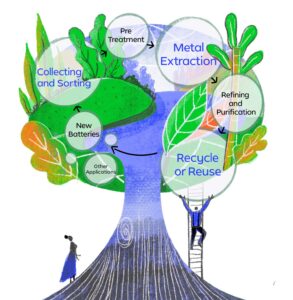Shaping a Circular Future: The Role of Battery Tech Metal Recycling in Sustainable Solutions
The future of sustainable energy is here and it’s electric!
As the demand for electric vehicles continues to rise, it is crucial to formulate a comprehensive plan to prepare for the future. By 2035, there will be millions of batteries reaching their end-of-life, leading to a significant amount of recycling feedstock. By implementing strategic measures at the earliest, we can proactively address potential negative consequences that may arise in the future. By acting now, we can prepare for this challenge and address it in a sustainable manner when the time comes.
The process of recycling lithium-ion batteries can play a vital role in reducing carbon dioxide emissions which, in turn, helps in establishing a cleaner and greener future. As we are all aware, lithium-ion batteries serve as the core energy storage technology for electric vehicles, stationary storage applications, power tools, and electronic devices such as phones and laptops. By implementing an efficient recycling system, we can significantly impact the overall carbon footprint, thus taking a step towards an environmentally sustainable tomorrow.
Research shows that recycling lithium-ion batteries can cut emissions by 50-70% compared to producing new ones (UNEP). As a result, by 2040, this simple act could result in a 25% reduction in demand for primary lithium. (source)
Recycling will ultimately also reduce the demand for minerals, as the metal units are not consumed and even though the technology may be at end of life the metals themselves can be re-used if extracted. Although the impact between now and 2030 is likely to be small, recycling’s contribution to moderating mineral demand will be critical after 2030 (IEA).
Let us explore the situation further.
The Significance of Battery Tech Metals
Battery tech metals play a pivotal role in modern society as they are essential components in the development of efficient and sustainable energy storage systems. These metals (including lithium, cobalt, manganese, graphite and vanadium to name but a few) are primarily used in energy storage. Other boutique metals including high purity quartz, high purity alumina, nickel and rare earth elements are also required for renewables technologies which may have similar recycling potential.
The growing demand for electric vehicles and the expansion of a renewable energy generation has fuelled the need for more and more battery tech metals. The importance of these metals lies in their electrochemical properties, which when used in the right combination together result in a usable energy storage product. Hence why particular individual minerals and metals are crucial for the transition towards clean and renewable energy sources.
Like all natural resources, battery technology metals are finite resources with limited global reserves, making their sustainable management and recycling essential. Recycling battery tech metals is not only vital to prevent inefficient global waste volumes, but also to reducing the future need for new primary mined materials.
Sources of Recycling Feedstock
There are two main sources of recycling feedstock: manufacturing scrap and end-of-life batteries.
Feedstock from manufacturing scrap can come from various sources. Manufacturing scrap refers to the discarded materials and components generated during the battery manufacturing process. A potential source of battery waste from manufacturing scrap also includes end-of-line testing waste which comprises of non-working batteries or units that don’t pass inspection.
End-of-life lithium batteries refer to the state of the battery when it can no longer hold optimal charge or provide the expected battery performance. The performance criteria for end-of-life lithium batteries include reduced capacity, shorter battery life, and increased charging time. When a battery reaches the end of its life, it may also be more likely to overheat or experience other safety issues. Moreover, damaged, or punctured batteries from a car in an accident are also considered in the end-of-life category as they can pose fire risk.
Recycling facilities have improved their capabilities and can now recover a significant amount of cobalt and lithium from used batteries and manufacturing scrap. These facilities can recover nearly all the cobalt and over 80% of the lithium from these sources.
The recovered metals are being resold by recyclers at prices that are competitive with those of mined materials. In addition to cobalt and nickel, recycling facilities also recover other valuable materials such as aluminium, copper, and graphite. (source)
An Overview of Battery Metals Recycling Process
The recycling process for lithium-ion batteries involves several key steps. Firstly, the used batteries are collected and sorted based on their composition and size. Then, a pre-treatment phase removes the outer casing and separates the battery components using mechanical processes.
Next, valuable metals are extracted from the battery components. The are number of ways to do so, but the most popular method is using hydrometallurgical proc
esses like leaching and solvent extraction. These extracted metals undergo refining and purification to attain high-purity metals through processes such as electrolysis or precipitation.
Finally, these metals can be used to manufacture new batteries or other products, or they can be sold in the market for various applications, reducing the need for new metal mining and refining. It’s important to note that the recycling process may vary based on the specific type of battery being recycled.

Current Challenges in Recycling Battery Tech Metals
The recycling of battery tech metals presents several challenges that need to be overcome. Despite significant progress, there are still a number of barriers in the way. Some of the key challenges currently faced by the industry today:
- Generally, all metals are leached into a single solution. The resulting complex composition of the liquor poses a challenge in selective separation and recovering each metal efficiently and economically.
- Variability in feedstock can exacerbate this issue.
- Lack of innovative business models and government incentives to support the development of a robust battery metal recycling industry, solving the economic viability issue.
- Collection and transport of end of life batteries requires infrastructure and co-ordination (as has been the case historically for other recycling industries), which is yet to be planned.
Beyond Recycling: Exploring the Economic and Environmental Advantages of Battery Reuse
Reuse refers to the process of repurposing or refurbishing used batteries for secondary (or perhaps tertiary) applications. While recycling focuses on extracting the metals from end of life batteries, reuse aims to extend the lifespan and utility of batteries beyond their original purpose – typically by deploying to a lower performance requirement sector.
With proper maintenance and suitable applications, batteries can be reused multiple times. This not only reduces the overall demand for new battery metals, but also maximizes the value derived from existing resources. The reuse of batteries can provide cost savings, especially in applications that do not require the highest level of performance. For instance, repurposed EV batteries can be used for energy storage systems, providing a more affordable solution compared to new batteries. Reusing batteries significantly reduces the carbon emissions associated with manufacturing new batteries.
We can conclude by saying both recycling and reuse play essential roles in the management of battery tech metals. While recycling addresses resource conservation and environmental concerns, reuse offers economic advantages and reduces carbon emissions. As we continue to innovate and advance, it is crucial to prioritize these principles when it comes to handling battery tech metals, ensuring that our pursuit of sustainable energy remains aligned with environmental and economic sustainability.
Prolonging the use of a battery prior to recycling therefore has demonstrable advantages to the world.
Wave International’s Role in Creating a Sustainable Supply Chain
Wave International is a leading-edge engineering consultancy firm that has focussed on the battery minerals and chemicals sectors for more than 20 years. Wave’s technical capability, global market presence and long relationships with internationally recognised experts ensure that it occupies the top-tier as a proponent of the battery minerals supply chain.
Wave International has established its capability in the lithium, vanadium, graphite, cobalt, and other technical minerals, and is a long-standing provider of subject matter expertise, financing strategies, leading-edge engineering, and tailored project strategies.
Our range of battery recycling and downstream processing solutions forms a crucial component of our service offerings to clients. Furthermore, Wave International is currently exploring different strategies for implementing circularity in traditional businesses. We are dedicated to facilitating the transition to a circular economy, by helping shape sustainable supply chains that transform conventional waste into valuable by-products.
By adopting sustainable recycling practices, we can contribute to a cleaner, greener, and more resourceful future.



